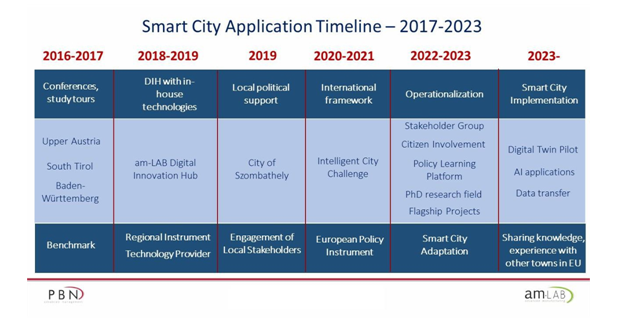Digital Innovation Hubs as Support Centers for Digitalization in European Smart Cities
Written by Balázs Barta, Márton Barta, and Tamás Gyulai
The European Union is guiding cities towards a more strategic approach to boost their competitiveness in the realm of digitalization. One of the initiatives that spearheaded this shift was the Intelligent Cities Challenge (ICC), which brought together 136 cities between 2020 and 2022 to achieve smart, socially responsible, and sustainable growth through advanced technologies. The ICC participant city of Szombathely was the only city in Hungary that provided scope for strategic development that emphasized cross-border cooperation and international networking in the development of digital innovation hubs.
Consequently, this paper demonstrates that digital innovation centers can play an important role in the life of a modern city as actors of spatial planning and promoters of responsible innovation, according to EU guidelines and international practice.
European Context
Most European regions have digital growth as an objective or horizontal priority in their Smart Specialization Strategies (S3). This is because digitalization is one of the several megatrends (among globalization, demographic change, and climate change) which are fundamentally reshaping policies. Digital innovation can thus make important contributions to the economic and social development of cities, with the aim of creating a more efficient and livable urban environment through smart city development. The OECD (2020) defines smart cities as "initiatives that make effective use of digitalization to enhance the well-being of citizens and provide more efficient and sustainable urban services and environments with the participation of collaborating stakeholders." Digital innovation plays a central role in such a smart city concept, which, from a policy maker’s perspective, aims to get the most out of costly investments for the well- being of citizens.
Aligning smart specialization strategies with the general policies of the European Union is crucial in order to achieve the goals set. The European Commission therefore launched the Digitizing European Industry (DEI) initiative in 2016. The DEI coordinates with Member States and regions on common objectives. They identify the European network of Digital Innovation Hubs (DIHs) as an important tool in this process. DIHs act as a one-stop-shop where SMEs and mid- sized companies can test the latest digital technologies and receive training, funding advice, market information, and networking opportunities to develop their business through digital innovation (European Commission 2017).
Example for European DIH Operations in Hungary
Past experiences of industrial clusters in Europe demonstrate the role they play in supporting smart specialization areas: they have enhanced the digitalization of firms and supported innovation across clusters/industrial sectors where the European network of DIHs can play a catalytic role (European Commission 2012). This means that companies can have more success entering new markets when they develop competences to internationalize. It also means that new ways of integrating digitalization in less developed areas can be found (Gyulai 2021a).
The town of Szombathely, at the western border of Hungary, is a good example of digital innovation and urban development. The coordinating force behind their development process has been the Pannon Business Network Association (PBN). PBN was established in 2006, with its headquarters in Győr and its operational center in Szombathely, as a regional economic development organization in the Western Transdanubian region of Hungary, with the goal of strengthening the economic role of micro-to-medium-sized enterprises. PBN established its digital innovation hub, am-LAB, in 2017, with knowledge input from Upper Austria, South Tyrol, and Baden- Württemberg. The objective was to focus on the digitalization megatrend, and to overcome the challenge of adapting it to the local ecosystem. By 2018, Am-LAB concentrated mostly on manufacturing-related digitalization (robotics, autonomous manufacturing, 3Dvtechnologies, xR), followed by data science applications. This interpretation of the digitalization trend led to broad interest among multiple stakeholders (i.e., citizens, students, businesses, media and politicians). A key indicator of this was am-LAB’s almost 1,000 visitors on an annual basis.
Figure 1: Smart City Application Timeline 2017-2023.
Extrapolation of DIH Services for Smart City
Digitalization became increasingly seen as an enabler of further developments, such as smart cities. Consequently, as an organization supporting urban development, the service portfolio of PBN concluded in an abstract a higher level of impact on local and territorial policies. All of these actions and conclusions were data-driven, presented in easily understandable way, and utilized to draw the attention of policymakers to this problem. A key achievement at this time was the analysis, visualization, and breakdown of the city’s senior care services, which helped identify more efficient service administration methods that could deliver greater efficacy and impact with the same existing resources.
After a four-year collaboration between the am-LAB DIH and the city management, the city decided the partnership should become officially formalized and structured. PBN received a contract to prepare the Sustainable City Development Agenda, which was based on the Szombathely2030 strategic document, and elaborated on under the Intelligent City Challenge initiative. The Agenda included actions and projects with indicative timelines and specifically responsible organizations. Some examples of these actions and projects include a Greenfield R&D Center to be implemented with PBN, new services for the social care sector, smart city applications, and digitalization skills development for the local community.
Digital twin development of Szombathely has already begun under the leadership of PBN with a pilot case where the streets within a section of the town are input into an international simulation model. The digital twin was further developed by am-LAB, based on real-data physics, high-level simulation, sensor direct interface, PLC connectivity, and mixed reality. It is embedded into a green energy environment; therefore, it can be used as a fundamental model for smart city solutions.
Technological Enablers of DIH Services for Smart City
The most commonly recommended European platform for smart cities is fiware, since it enables open-source connectivity of multiple applications (i.e., mixed reality, sensor data, visualization, etc.). Consequently, in 2021-2022 am-LAB applied fiware solutions to the manufacturing sphere with a model developed for existing infrastructures. The fiware solution has already been presented on a European scale. It was also praised by Politecnico di Milano. It will be presented to the European Commission in Milan in November 2023.
An additional enabler of digital innovation is the advances made in artificial intelligence competency. Image recognition application based on neural network technology has been developed. This solution, together with data visualization, is currently for sale on a global level, in partnership with a multinational company.
Further Actions with European Scope
The Intelligent Cities Challenge continues in 2023 with a renewed policy agenda that covers smart mobility, energy, and the built infrastructure (ICC 2023). The ICC community shall continue to provide opportunities for knowledge and networking for joint R&D actions on the European level for smart cities. Szombathely continues its journey toward more sustainable city development, which can result in various new achievements for the city the coming years.
Another Hungarian town with smart city ambitions is Szeged, which has already learnt not only from the experiences of Szombathely through the knowledge transfer agreement, but also from Arad and Timisoara as active members of the network of ICC towns. Joint strategic planning of cross-border roadmaps for Szeged and Timisoara have been successfully achieved within the framework of TetRRIS project (Gyulai 2021b). These plans can be further enhanced by joint cross-border actions from digital innovation hubs throughout the coming years.
Acknowledgment
The research work presented in this paper was carried out with the professional support of the Doctoral Student Scholarship Program of the Co-operative Doctoral Program of the Ministry of Culture and Innovation financed from the National Research, Development and Innovation Fund.
References
- European Commission (2012), The role of clusters in smart specialization strategies, Publications Office of the European Union, Luxembourg, 2012, doi: 10.2777/43211
- European Commission (2017), Digital Innovation Hubs: Mainstreaming Digital Innovation across All Sectors, Roundtable on Digitizing European Industry, Working Group 1.[online] https://ec.europa.eu/futurium/en/system/files/ged/dei_working_group1_report_june2017_0.pdf
- Gyulai (2021a): „Digital Innovation Hubs as new paradigm for digital ecosystem development for Smart Cities”, „SMART REGIONS – Opportunities for sustainable development in the digital era” RSAI 2021 online conference, 26th May 2021
- Gyulai (2021b): Smart City development by Responsible Research and Development by cooperation with Digital Innovation Hubs, 4th SMART COMMUNITIES ACADEMY, Building Smart Communities for the Future, 8th October 2021, Kosice, Slovakia
- ICC (2023): Intelligent Cities Challenge 2.0 [online] https://www.intelligentcitieschallenge.eu/
- OECD (2020): Smart Cities and Inclusive Growth [online] https://www.oecd.org/cfe/cities/OECD_Policy_Paper_Smart_Cities_and_Inclusive_Growth.pdf
To view all articles in this issue, please go to September 2023 eNewsletter. For a downloadable copy, please visit the IEEE Smart Cities Resource Center.



To have the eNewsletter delivered monthly to your inbox, join the IEEE Smart Cities Community.
Past Issues
To view archived articles, and issues, which deliver rich insight into the forces shaping the future of the smart cities. Older eNewsletter can be found here. To download full issues, visit the publications section of the IEEE Smart Cities Resource Center.




